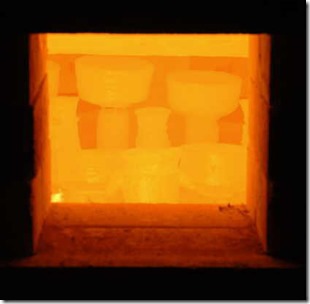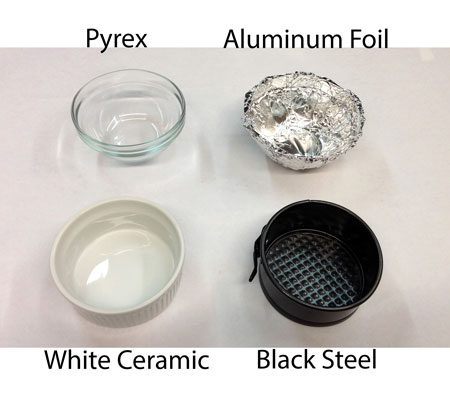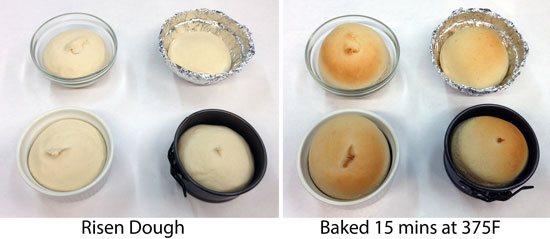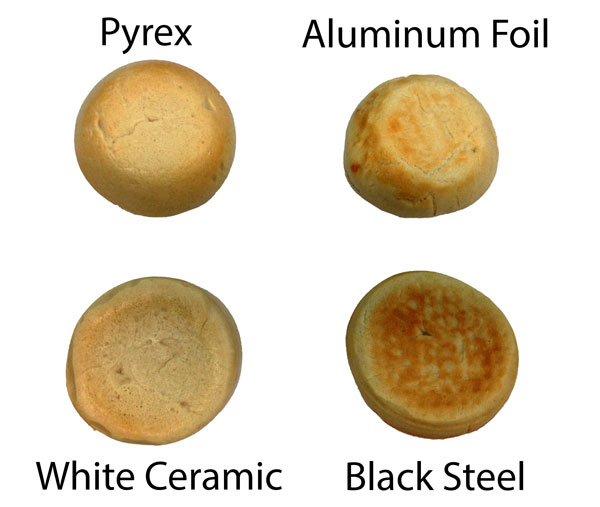| g e n u i n e i d e a s | ||||||
 |
 |
 |
 |
 |
 |
 |
| home | art and science |
writings | biography | food | inventions | search |
| you are what you heat |
|
Dec 2013 An oven's temperature control knob is the least reliable tool in the kitchen. Not only are most oven knobs off by 25F or more, how rapdily food cooks and browns depends as much on the color of the tray it rests in, as the temperature of the oven itself. In an oven, food heats by convection (hot air warming), conduction (transferring energy directly through contact with a hot surface like a pizza stone) and radiation (by absorbing infra-red energy emitted from the glowing electric or gas elements1). In most ovens, convection dominates, with conduction and radiation playing secondary roles. On a charcoal grill, radiation rules. Still, a black pan will brown more effectively than a white pan because it absorbs more light radiation. But many people think this is a myth. They are probably confused because one day in science class they ran across a picture like this, taken while peering deep inside a pottery kiln during firing: Since the pots and side walls of the kiln are all at the same temperature, they all radiate light of the same frequency and pulse with the same ghostly, deep red color. It's even hard to distinguish their edges. True, a black pot in a kiln absorbs heat more quickly than a white pot, but also emits energy more efficiently, so it cools off faster. A white pot reflects light and thus absorbs heat more slowly, but it also radiates heat more slowly. Called “reciprocity”, this principle ensures temperature equilibrium is maintained in a sealed oven once all the pots have heated up. By analogy (some people maintain), the color of your baking sheet is irrelevant. Or is it? Unlike a kiln, a kitchen oven is NEVER in equilibrium. If it were, not only would the shelves and roasting pan and oven walls all shimmer at 425F in a 425F oven, but so would the turkey! No one waits that long to reach equilibrium, or would be satisfied with the carbonized results. Plus, the 1200F electric element cycles on and off a dozen times an hour; on each cycle flooding the oven with intense, browning radiation. The fact is, due to evaporation and the insulating value of meat or bread dough, food is much cooler than the oven. So the color of the pan matters. All things being equal, a black steel pan heats up a bit faster than a white steel pan of the same thickness and material. A clear Pyrex pie plate transmits near infra-red energy from the cycling oven heater through the glass, to brown crust a bit more quickly than a white glass platter. While a thick shiny aluminum pie plate browns more slowly. But a double-insulated-air-gap cookie sheet, black or silvery, leaves the bottom of each ginger snap pale rather than brown. Insulation can trump color. We can illustrate these effects in a simple experiment. Four small bowls of the same size were each oiled and filled with 160 gms of pizza dough. One bowl was clear Pyrex, another white ceramic, the third black steel, and the fourth a sheet of heavy duty aluminum foil formed into a bowl shape:
After letting the bread double in volume, each bowl was placed on a shelf in the middle of a 375F electric convection oven. The bowls were all removed after 15 minutes. As you can see, the top of the bread browned, no matter which container:
But when you turn out the bowls, the bottoms of the bread (which faced the hot electric heating element on the base of the oven2), are quite distinct:
The highly conducting black spring-form pan produced the deepest brown color. Not only is the pan thinner than the ceramic/Pyrex containers, its thermal conductivity is 200 times higher. So between the pan's dark absorbing color, high thermal conductivity and low thermal mass, black steel is the browning champion. The second brownest crust resulted from the aluminum bowl! True, it's high reflectivity was a barrier to radiative heating, but aluminum foil is 20x thinner than steel and 250x thinner than ceramic. Thus its second place finish. The third fastest is clear Pyrex- although thermal conductivity is low and the bowl is thick, near infra-red energy can pass through the glass into crust. And be absorbed by the glass. Either way, compared to the white ramekin it heated faster and more uniformly. Finally, the dough in the white bowl began to brown just before the test was over. The dough was pale and slightly undercooked. But it did rise a bit higher- the cooking delay slowed the formation of a hard crust, giving the bread greater "oven spring". And sometimes, as in a soufflé, a lighter crust is desirable. Other properties, such as the container's position in the oven and its shape affect browning. But color, mass and thermal conductivity dominate until the food is as dry as sand and achieves temperature equilibrium with the rest of the oven. If you want to brown food quickly, go for thin black steel. If you want to delay browning, go for a thick insulated shiny container.
|
|
-------------------------------------------------------------------------------------------------------- 1 And to a lesser extent, the oven's hot walls. 2 I normally leave a perforated aluminum baking sheet on the bottom shelf of our oven. This tray blocks direct infrared light from preferentially browning food on the lower shelves, and creates a more uniform temperature profile. And thus more uniformly cooked food. When browning smashed potatoes or crispy ginger snaps, I remove this tray, so the infrared energy can work its magic. Curiously, in a well insulated oven, the heater cycles on and off infrequently, so the browning effect is reduced. But in an old, poorly insulated oven it may cycle five times as often, giving cookies a radiation burn. Sometimes it is not the chef, but the chef's tools. So you might discover an insulated cookie sheet makes all the difference in one oven, and was a waste of money in another.
|
 Contact Greg Blonder by email here - Modified Genuine Ideas, LLC. |



